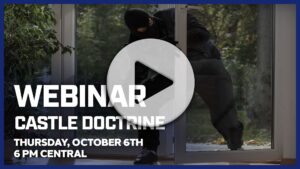The world of firearms and self-defense is layered with nuances, which unfortunately means it’s riddled with myths and misconceptions. A well-informed individual not only ensures their safety but also the safety of those around them. Here, we debunk ten of the most persistent myths PLUS a webinar.
1. A gun guarantees safety: One of the most prevailing myths is that merely possessing a firearm ensures personal safety. A firearm is an inanimate object this is only as effective as the person holding it. It is an extension of yourself. Your safety is determined by how capable you are with your firearm. To become proficient, you should attend regular training, practice often, and become familiar with your specific firearm. A firearm in the hands of an untrained individual can be more of a liability than a safety tool. As a responsible gun owner, you should also familiarize yourself with the laws where you live and safe storage methods for your firearms. Responsible gun ownership is not just about pulling the trigger; it’s about knowing when and how.
2. Shooting to wound is preferable: Hollywood movies often depict heroes shooting the gun out of the villain’s hand or hitting their leg to incapacitate them. In a real-life crisis, attempting to wound can be dangerous. When engaged in a fast-paced self-defense situation where lethal force is necessary, it is best practice to aim for “center mass”, the attacker’s torso, for the greatest hit probability and the many vital organs there. Situations requiring self-defense often demand immediate and effective responses, and aiming to wound can result in inaccurate shots, leading to unintended consequences. Shoot to stop the threat is the way to go.
3. “Stand Your Ground” laws mean shoot first: These laws often stir controversy. While they remove the obligation to retreat in certain situations, they don’t provide blanket permission to resort to deadly force. The user must genuinely believe they’re in imminent danger, and the use of force must be reasonable under the circumstances.
Watch our webinar over Castle Doctrine to learn more:
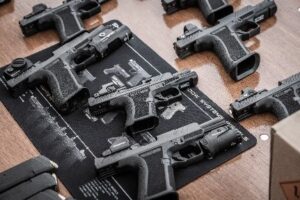 4. All guns serve the same purpose: Just as all vehicles aren’t designed for the same function, firearms too come in various shapes, sizes, and calibers. Each is tailored for specific purposes, from hunting and sport to personal defense. Assuming they’re all the same can lead to incorrect usage, which can be dangerous.
4. All guns serve the same purpose: Just as all vehicles aren’t designed for the same function, firearms too come in various shapes, sizes, and calibers. Each is tailored for specific purposes, from hunting and sport to personal defense. Assuming they’re all the same can lead to incorrect usage, which can be dangerous.
5. Guns are the best and only home defense: Firearms can be effective for home defense, but they’re just one tool in a broader safety strategy. Consider your home security as layers where the final layer is a firearm in your hand. Your outer layer should ideally be a tall, sturdy fence. The next layer, a strong exterior door with a high-quality lock. The last layer before your safe area, such as your bedroom, is an interior door with a lock. Putting as many layers of protection between you and a potential home invader is an important part of home defense. Other measures, such as alarm systems, motion sensor lights, and even guard dogs, can help diversify one’s safety measures to ensure a comprehensive defense system.
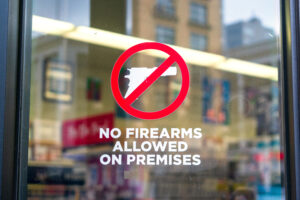 6. Gun-free zones are the safest places: The concept behind gun-free zones is noble, intending to keep firearms out of sensitive areas. However, it’s essential to understand that criminals, by nature, don’t abide by laws. An unprotected zone can, unfortunately, become a target.
6. Gun-free zones are the safest places: The concept behind gun-free zones is noble, intending to keep firearms out of sensitive areas. However, it’s essential to understand that criminals, by nature, don’t abide by laws. An unprotected zone can, unfortunately, become a target.
7. Silencers turn gunshots into whispers: Thanks to popular media, many believe that a silencer, or more accurately, a suppressor, makes a gunshot almost silent. In reality, while it reduces the noise and muzzle blast, a suppressed gunshot is still loud and recognizable. Read our other blog taking a deeper look at muzzle devices: https://firearmslegal.com/an-unmuzzled-look-at-muzzle-devices/
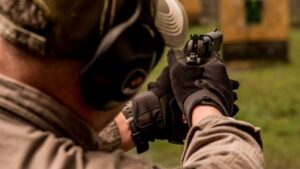
8. Owning a gun requires no ongoing training: Some believe that once they know how to shoot, no further training is needed. This couldn’t be further from the truth. Just like any other skill, proficiency in firearm usage requires regular practice. Rules, regulations, and even one’s physical ability can change, making ongoing training essential.
9. Concealed carry owners frequently prevent crimes: While there are instances where a concealed carry holder has prevented a crime, it’s not an everyday occurrence. Overemphasizing these instances can create a skewed perception of reality.
10. More guns automatically mean more crime: It’s an oversimplification to correlate gun availability directly with crime rates. Numerous factors, including socio-economic conditions, law enforcement efficiency, community programs, and education, play roles in crime dynamics.
It’s essential to approach the realm of firearms and self-defense with a well-informed perspective. Myths can distort our perceptions, leading to misguided decisions. By debunking these myths, we aim to provide a clearer, safer, and more knowledgeable approach to firearm ownership and usage. Always remember, that knowledge backed by tools like FLP can provide comprehensive assurance and peace of mind in a world filled with uncertainties. Protect yourself, we’ll protect you.
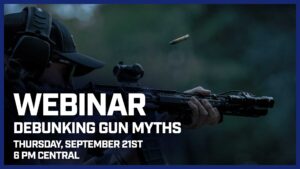 Check out our webinar over debunking gun myths as we discuss even more of the top popular gun myths.
Check out our webinar over debunking gun myths as we discuss even more of the top popular gun myths.

